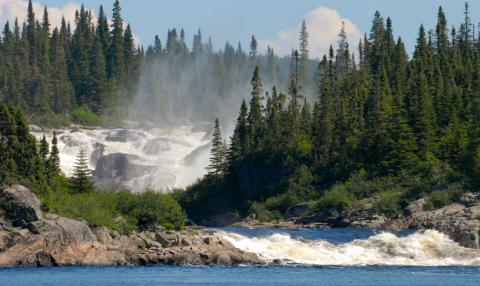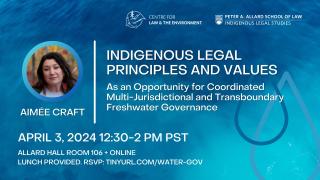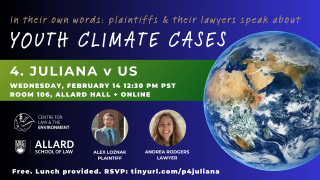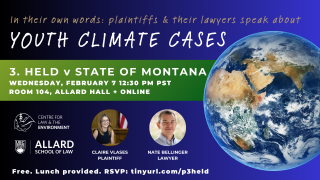From “Green Soup” to Legal Person: An Analysis of Spain’s New Law Recognizing the Mar Menor Lagoon as a Legal Person

Emma Chapman
Allard JD 2023
Jul 26, 2023
“The time has come to make a qualitative leap and adopt a new legal-political model, in line with the international legal vanguard and the global movement for the recognition of the rights of nature,” declares the preamble of a new Spanish law (unofficial English translations by DeepL Translate). Indeed, by recognizing the legal personhood of the Mar Menor lagoon, this Law represents a monumental leap for European law, one that may irrevocably change the landscape of environmental protection on the continent.

Located on the southeastern coast of Spain abutting the Mediterranean Sea, the Mar Menor lagoon is the largest saltwater lagoon in Europe. For decades, it was a renowned natural landmark, boasting pristine shallow waters teeming with life. However, from 2016 to 2021, fertilizer run-off from nearby farms caused an enormous malignant algae bloom. The resulting eutrophication asphyxiated marine life. Mar Menor’s once pristine waters became a “Green Soup”, its beaches littered with thousands of dead fish.
In an effort to restore and protect Mar Menor, the Spanish Parliament passed Law 19/2022 in September 2022. The Law recognized the lagoon and its basin as a legal person and granted it a set of explicit legal rights.
A Canadian comparison
How does this law compare with the Magpie River Resolution in Québec, Canada’s first and only example of a rights of nature approach to environmental protection? In February 2021 the Innu Council of Ekuanitshit and the Minganie Regional County Municipality passed similar but separate resolutions that recognized the legal personhood and rights of the Magpie River (Mutehekau Shipu in the Innu language), which is located in the Côte-Nord region of Québec. As leading rights of nature scholar David Boyd stated, the Resolution is culturally revolutionary because it is the first time Canadian law has regarded nature as something other than property.

1. Quantity and quality of rights
The first key area of comparison between the two laws is the quantity and quality of the rights recognized for each respective ecosystem. The Mar Menor Law recognizes four legal rights, while the Magpie River Resolution includes nine. Both laws include the right to exist and evolve naturally, the right to regeneration and restoration, and the right to protection. However, the Magpie River Resolution grants several additional rights. Of particular interest is the river’s right to be free from pollution. In contrast, Mar Menor enjoys the right to be protected from activities that pose a risk to, or may damage, its ecosystem. While at first glance, this may seem to be a weaker right, it is actually broader, and thus likely more effective than the Resolution provision. By framing the right in terms of “risk” rather than actual pollution, the Law not only captures a wider variety of harms than pollution, but it also lowers the threshold for preventative intervention.
Some of the other rights granted by the Magpie River Resolution include the right to respect for its natural cycles, the right to maintain its natural biodiversity, the right to maintain its integrity, and the right to perform essential functions within its ecosystem. The closest corollary in the Mar Menor law is embedded within the right to exist and evolve naturally which explains that this right means respect for ecological law, which ensures the balance of the ecosystem.
2. Guardians
Second, both laws appoint Guardians for each ecosystem. This is a common feature of many rights of nature laws around the globe. The Guardians of the Magpie River are to be appointed by the regional county municipality and the Innu Council of Ekuanitshit. These Guardians are empowered to determine the river’s best interests and take legal action on its behalf to recover compensation for damage to the river.
In contrast, the Mar Menor Guardian consists of three distinct entities: a Committee of Representatives, made up of political actors; a Monitoring Commission, comprised of representatives from each riverside and basin municipality and from a number of economic, social, and environmental sectors; and a Scientific Committee, made up of independent scientists and experts on the Mar Menor. This structure is arguably more representative, because it provides for the inclusion of individuals from a variety of backgrounds. It may also prove to be more scientifically robust than the Resolution structure, given the explicit requirement for a separate committee of independent experts. However, unlike the river Guardians, the lagoon Guardians are not explicitly empowered to take legal action on Mar Menor’s behalf. This seeming omission makes more sense when the Law’s enforcement mechanisms are examined.
3. Enforcement mechanisms
First, the Mar Menor Law states that any violation of the guaranteed enumerated rights by anyone, including governmental and non-governmental actors, will generate criminal, civil, environmental, and administrative liability and/or prosecution. Second, it renders invalid any statute that violates the Law’s provisions. Finally, the Law creates a broad public cause of action that permits any natural or legal person to enforce the rights and prohibitions of the Law, with a right to full indemnity for litigation costs where the claim succeeds. This type of cause of action is not novel; Tamaqua Borough in Schuylkill County Pennsylvania created a similar mechanism in 2006. However, it is truly a “qualitative leap” for environmental protection in Europe.
For example, whereas the Magpie River Resolution “strongly urges” all governments to provide the funding necessary to implement the River’s rights, the Mar Menor Law sets out a set of mandatory obligations for all levels of government. These obligations include the restriction of activities that may lead to the extinction of lagoon species, and the prohibition or limitation of the introduction of organisms or materials that might permanently alter the lagoon’s “biological heritage”.
The difference in the strength of language and enforcement may be largely attributable to the level of government in issue. The Law was passed by the national Parliament of Spain, whereas the Resolution was passed by the municipality of Minganie in Québec and the Innu Council of Ekuanitshit, which do not have the same legislative powers as higher levels of the Canadian government. However, the relative absence of legal obligations and enforcement mechanisms in the Resolution is notable.
4. Definition of legal personhood
Beyond the rights and enforcement mechanisms, an interesting similarity between the Law and the Resolution is the broad definition of the ecosystem receiving legal personhood. For Mar Menor, the waterbody, the watershed, and all related aquifers are collectively defined as a legal person—1600 square kilometers of protected space. In contrast, Magpie River’s nine rights are held by the waterbody and the basin, an area of 7650 square kilometers. The benefit of such broad definitions is the ability to extend protection to a significantly larger environmental area, whether developed—like the Mar Menor Lagoon—or not, in the case of the Magpie River. The success of the rights of nature approach for such different landscapes highlights its adaptability and the range of contexts in which it can be used.
Implications
The recognition that natural entities such as trees, rivers, and ecosystems have legal rights has evolved from an academic aspiration to tangible law in countries around the world. Indigenous people have consistently influenced and often spearheaded calls for most laws recognizing the rights of nature. The Magpie River Resolution is one such example. It was the unwavering leadership of the Innu Nation, alongside the municipal government and various environmental groups, that lead to the enactment of the Resolution.
The central role of Indigenous peoples in the rights of nature movement is often overlooked. While Spain does not have Indigenous groups because of its particular history, it modeled the Law on examples of rights of nature laws from countries such as Ecuador, India, and New Zealand.
The Law introduces a new approach to environmental protection into the European legal landscape. Existing Western-colonial environmental law views nature as an entity outside of human culture and experience. The rights of nature model invites a different approach: one that views nature as intrinsically valuable and of central and irrevocable importance to human existence and flourishing. This is reflected in the preamble to the Law, which explicitly acknowledges the biocultural role Mar Menor plays in the lives of local citizens. It also recognizes the need to shift from an anthropocentric approach to one premised on balance and respect. Whether the Law will achieve its lofty conservation goals remains to be seen, but its strong message and robust enforcement mechanisms provide hope for a more sustainable future.
- Centre for Law and the Environment


